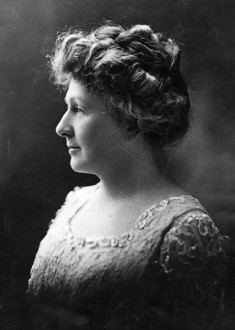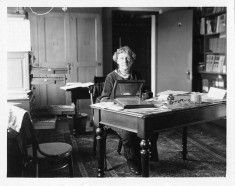| Annie Jump Cannon | |
|---|---|
 |
|
| Astronomer | |
| Specialty | Stellar classification |
| Born | Dec. 11, 1863 Dover, Delaware |
| Died | Apr. 13, 1941 (at age 77) |
| Nationality | American |
Annie Jump Cannon was an American astronomer. She was particularly known for her work on star catalogs, which significantly advanced the advent of modern stellar classification. Cannon worked with Edward C. Pickering to develop the Harvard Classification Scheme, the earliest attempt at a comprehensive organization of stars by the temperatures at which they burned. She was also responsible for the discovery of a large number of variable stars.
Early Life and Education
Cannon was born in the Delaware city of Dover on December 11, 1863. After a successful basic education, she became one of the earliest women from her state to be enrolled in college, attending the popular Wellesley College. After graduating in 1884, she spent a quiet decade, mostly at home.
However, in 1894, she returned to the same establishment in order to carry out graduate-level research in physics, mathematics, and astronomy. The following year, she registered at Radcliffe College as a special student, and remained there for two years.
Cannon Gets into Harvard
At this time, the Harvard College Observatory had recently elected Edward C. Pickering as its director. He wished to increase the number of female assistants on the observatory staff, and he told Williamina P. Fleming to recruit them.
In the last 15 years of the 19th century, she brought in around 20 women, one of whom was Cannon, who was added to the staff list in 1896. She began her work at the observatory by sorting through photographic plates containing star spectrum lines. She would go on to have considerable importance in the field of star classification based on spectral returns.
Beginning Her System
At first, Cannon concentrated on variable stars, and she discovered over 300 of them while sorting through the photographs she had been given. Many of these were picked out because of the particular characteristics of their spectral signatures.
She used these results to overhaul the established Harvard method of classifying stars, considerably refining the simple alphabetical shorthand that had been used up until that point. While engaged on this work, Cannon proved that the great majority of stars could be sorted into a small number of types, and that most of these could be arranged continuously.
Stellar Classification
 In 1901, after five years researching these stars, Cannon produced a description in which she gave details of over 1,100 bright stars. She went on from this to produce the Henry Draper Catalogue, a definitive list of almost every star brighter than the 10th magnitude.
In 1901, after five years researching these stars, Cannon produced a description in which she gave details of over 1,100 bright stars. She went on from this to produce the Henry Draper Catalogue, a definitive list of almost every star brighter than the 10th magnitude.
The reference, which contains the details of about 225,000 stars, was named after the man who had pioneered the photography of star spectra. Cannon’s classification for the Catalogue was first explained by her in 1900, although she made some minor modifications in 1912.
The four years from 1911 to 1915 were Cannon’s busiest period in classifying stars for the Catalogue. The first volume was ready to go to the presses in 1918, but it was a further six years before the ninth and last installment appeared. Following this, Cannon worked on an extension covering a further 47,000 stars, which was completed in 1936.
She then moved on to working on the Cape Zone and Yale Zone Catalogues, although her work was still not finished at the time of her death and no fewer than 86,000 classifications appeared in 1949, some years after her death.
Later Life and Legacy
In 1922, the International Astronomical Union accepted the classification system that had been worked out by Cannon as the global standard for stellar spectrum classification. Cannon herself went to Peru that year, spending about six months at Arequipa in order to take photos of southern star spectra.
By this time she was an honorary member of the Royal Astronomical Society: at the time of her election in 1914, ordinary membership was still restricted to men. She was also made curator of Harvard’s collection of astronomical photographs, a role she held from 1911.
Cannon received a number of awards from the 1920s onward, although Harvard itself was rather inactive in this department. She was the first woman to be awarded an honorary degree from the University of Oxford and in 1931, she won the National Academy of Sciences’ Draper Medal.
The following year, she was awarded the Ellen Richards Prize, donating it to the American Astronomical Society to itself award to distinguished female astronomers. Cannon, who was profoundly deaf but never wore a hearing aid, was vetoed for membership of the National Academy of Sciences by Raymond Pearl for this reason. She died in Massachusetts on April 13, 1941, only a few months after retiring.